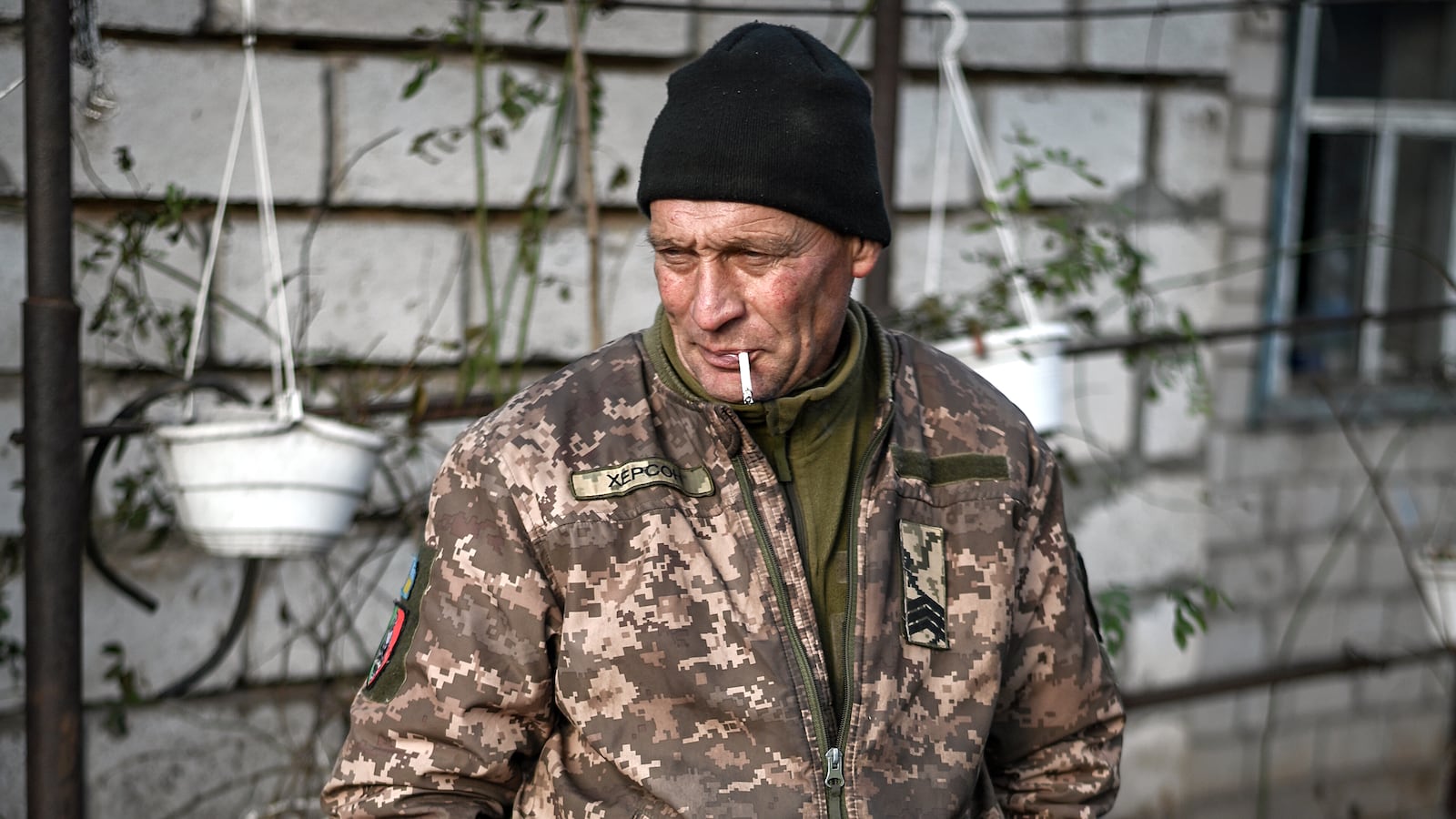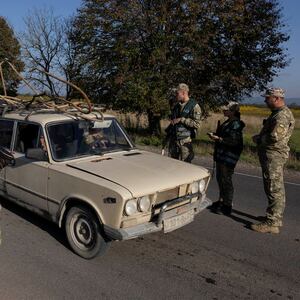CHASIV YAR, Ukraine—In front of a small country house in eastern Ukraine, two gray-haired Ukrainian soldiers are tinkering with a worn-out dune buggy, their hands and faces covered in grime. The rickety contraption is powered by an engine ripped out of a Soviet-built Lada car and wouldn’t look out of place on the set of a Mad Max movie. “We built it ourselves,” says “Kherson,” who introduces himself as the commander of the unit before inviting us in for a cup of instant coffee.
The frontline is located a couple of miles away and artillery and the roar of jet engines echoes regularly in the distance, yet Kherson seems oblivious to the danger: in spite of his age and the injuries he’s already sustained, the father of three tells us he’s been fighting at the front for months without leave. “Someone has to be doing the fighting,” he says with a wide grin that reveals half a dozen metal fillings. As part of the 17th tank brigade of the Ukrainian army, Kherson’s unit is tasked with conducting medical evacuations near the devastated town of Chasiv Yar, in the Donetsk oblast.
Following the fall of the neighboring city of Bakhmut last May, Chasiv Yar has come under increasing pressure from Russian forces set on conquering the entirety of Ukraine’s eastern Donbas region, and only a handful of the town’s 12,000 inhabitants still remain, surviving in the basements of bombed-out residential buildings. “On average, we go out once or twice a day, but it depends on how intense the fighting is,” Kherson tells us. The morning of our visit, the homemade buggy used by the unit to evacuate casualties had broken down, impeding their operations and leaving the men frustrated.
Warming his hands over the stove, Kherson acknowledges that his unit is currently understrength after suffering casualties, adding that most of the men under his command are aged 50 and older. “We took a direct hit from a tank, it blew off the legs of a soldier and I took some shrapnel,” he says, showing the scar tissue on his right hand where a small piece of smoldering metal had hit him a couple of months prior.
Despite still having some shrapnel lodged in his cheekbone, Kherson was back at the frontline within days of being injured. When they’re not in the field, the man says that he uses the unit’s Starlink satellite system to keep in touch with his three children and his wife over social media: “I miss them, but I’d rather be the one doing the fighting instead of them.”

“Kherson,” right, looks on as other soldiers repair a broken-down dune buggy.
Justin Yau/The Daily BeastTensions over mobilization numbers between the Ukrainian Armed Forces and President Zelensky spilled over into the public realm this month when outgoing army chief Valerii Zaluzhny wrote an essay published by CNN complaining that he had not been provided with sufficient men. “We must acknowledge the significant advantage enjoyed by [Russia] in mobilizing human resources and how that compares with the inability of state institutions in Ukraine to improve the manpower levels of our armed forces without the use of unpopular measures,” he wrote.
As the war hits its second anniversary Saturday and casualties continue to mount, Ukraine has had to mobilize increasingly older soldiers to man the trenches and fend off intensifying Russian assaults all along the country’s sprawling frontline. A foreign instructor with extensive combat experience, who asked to remain anonymous, told The Daily Beast that the newer recruits were clearly of a different vintage. “The soldiers that I’m training now are significantly older, many come from hard labor, they have back problems, knee problems, some are career alcoholics,” he said. Storming a muddy or frozen trench isn’t as easy for a 50-year-old man as it is for a younger soldier.”

Vitaliy, a soldier of the 17th Tank Brigade in a ruined village near Chasiv Yar, Ukraine.
Justin Yau/The Daily BeastLate last year, an officer of the 28th Mechanized Brigade we had met in a cafe in Kramatorsk, in the Donetsk region, confirmed to the Daily Beast that conscripts now accounted for “up to 90 percent” of some units’ personnel: “Many of the soldiers under contract are either dead or injured, so we have to mobilize to replenish our ranks,” he said.

“Miner,” a member of the medical evacuation crew.
Justin Yau/The Daily BeastWhile there are no official statistics available on the average age of soldiers currently serving in the Ukrainian army, government officials have ventured out estimates: in an interview with “The New Voice of Ukraine,” Serhii Rakhmanin, a member of the Ukrainian parliamentary committee on national security, defense and intelligence claimed that the average age of a Ukrainian soldier was now between 40 and 45 years old. “This applies not only to territorial defense brigades, but also, for example, to linear mechanized brigades and even units that should have been better prepared,” he added. “Such as, for example, mountain assault or amphibious assault [brigades].” A few weeks prior, adviser to the head of the President's Office Serhii Leshchenko had made the startling claim on Ukrainian television that the average age in some companies was “around 54 years.”
Yet, some of the men withstanding the Russian onslaught in the country’s East are older still: a couple of days prior to our meeting with Kherson, we had driven to Chasiv Yar itself to speak with drone operators from the 17th brigade. There, we parked our car next to an abandoned fire station before heading towards the center of the town, making our way down deserted avenues lined with burnt-out Soviet-style residential buildings, broken glass crunching under our shoes. As we turned the corner of a red brick building riddled with shrapnel holes, we came across a handful of Ukrainian soldiers from the 93rd brigade digging a trench by the side of the road. One of them excitedly introduced himself as “Batya” (which translates as “Father”), and told us he was celebrating that day his sixty-second birthday under Russian shelling. “Though I'm pretty spry for my age,” he adds proudly, before whipping out his phone to show us a video. Recorded by a Ukrainian drone hovering above the frontline, the footage shows Batya running out of a trench towards a Russian armored vehicle, before dropping a grenade through its open hatch. Moments later, the grenade detonates and plumes of white smoke come billowing out of the vehicle. “Not bad for an old man,” he says with a smile.

Soldiers work to repair the broken-down dune buggy.
Justin Yau/The Daily Beast“Even though some of the soldiers are much older, they still have the desire to keep on fighting,” confirms the foreign instructor over the phone. “I have heard a great number of times those older soldiers saying that they’re fighting precisely so that the younger generations don’t have to.”
Yet as the Russian invasion of its neighbor approaches its second anniversary, this younger generation could be increasingly called upon to shoulder the country’s war effort: On Jan. 30, the Ukrainian government submitted a revised draft of its contentious mobilization law, which, among other provisions, would lower the age of conscription from 27 to 25.








